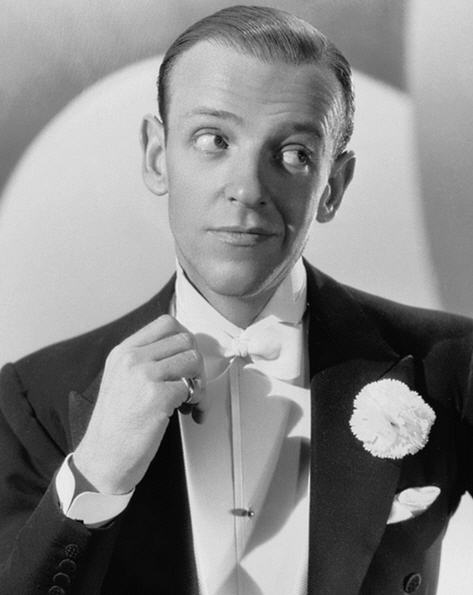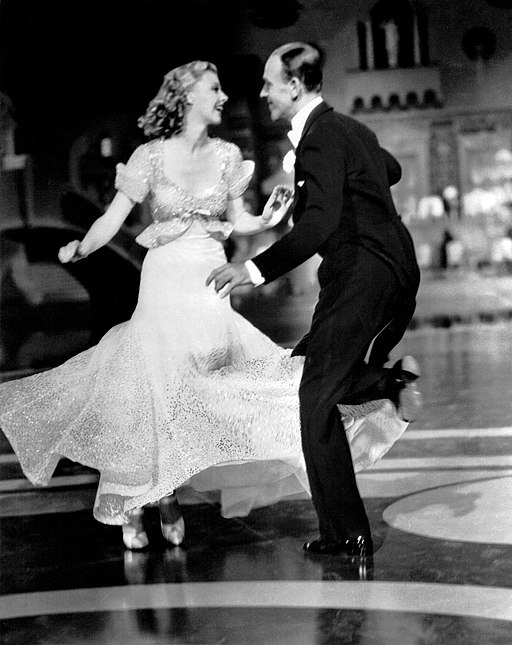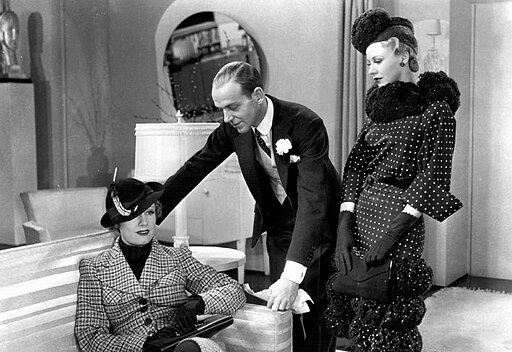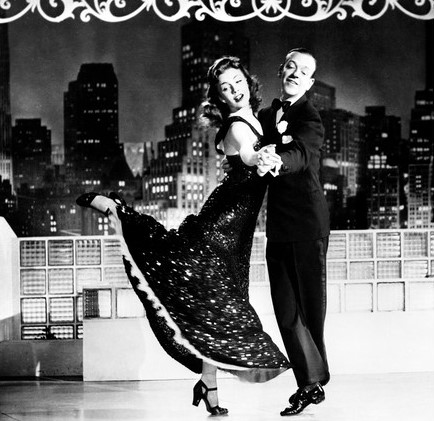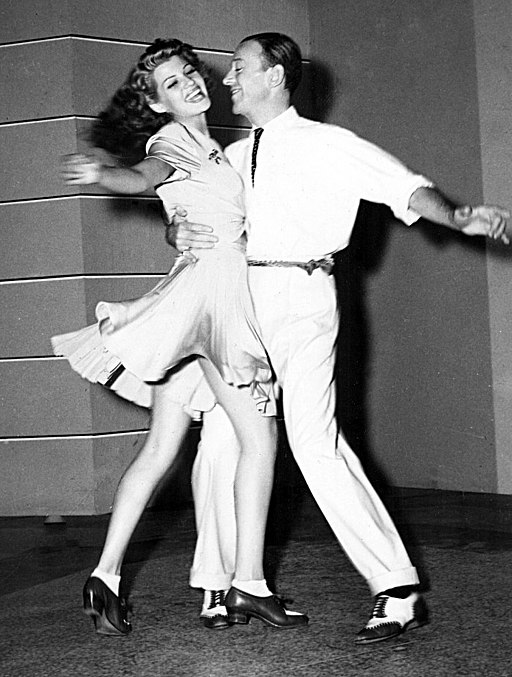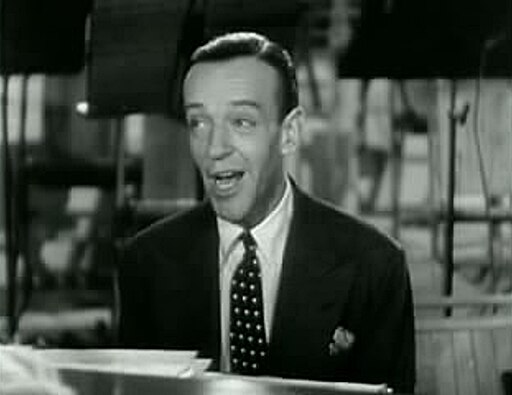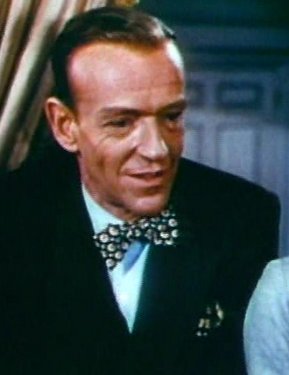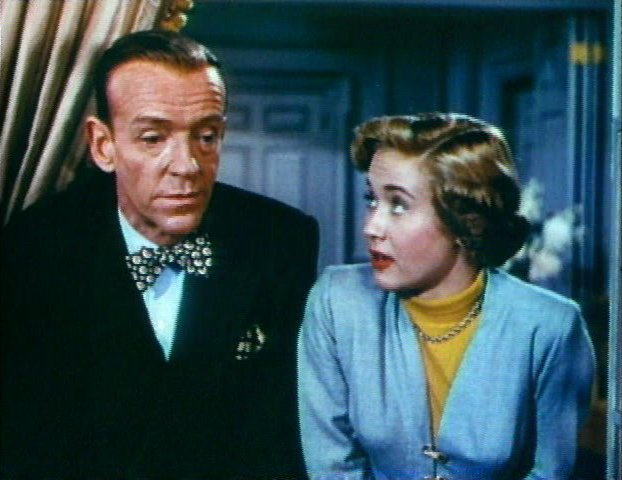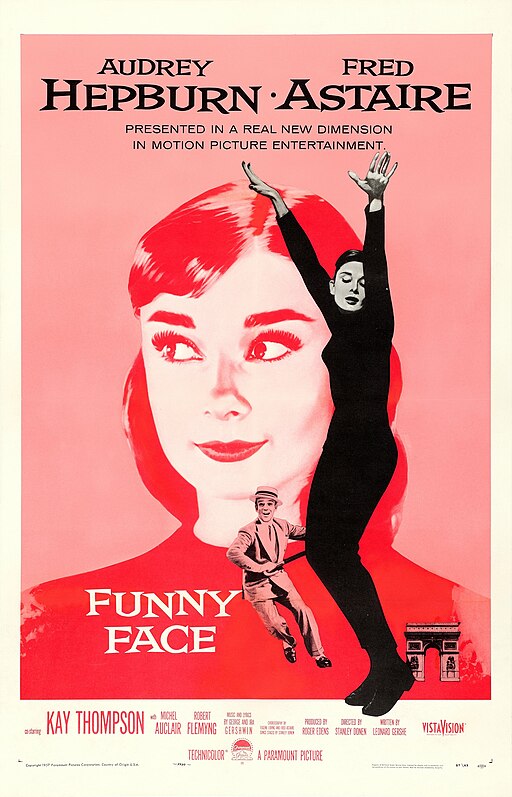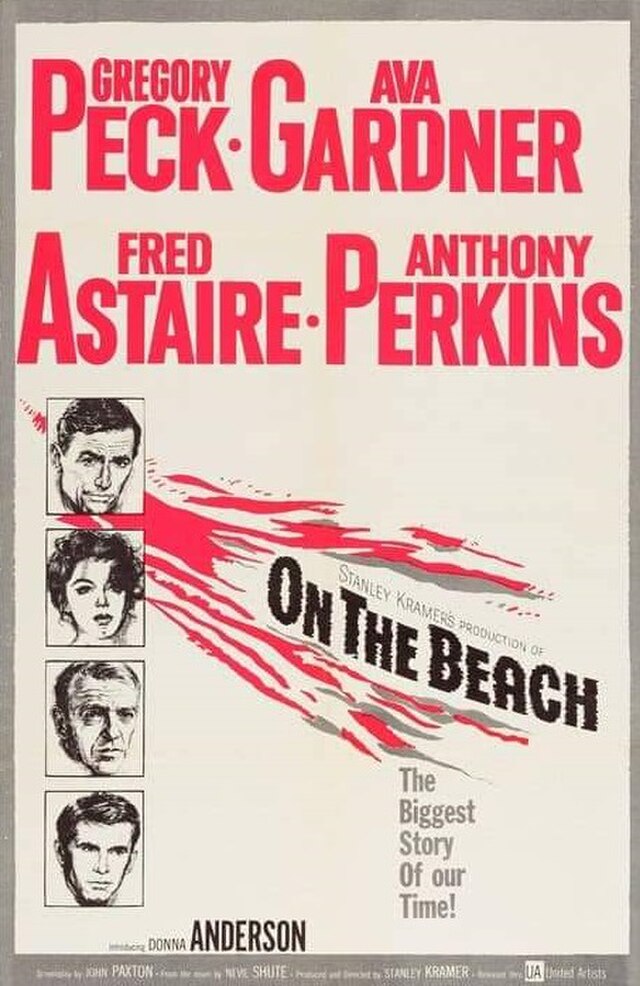Fred Astaire
back| Full Name | Frederick Austerlitz |
| Stage Name | Fred Astaire |
| Born | May 10, 1899 |
| Birthplace | Omaha, Nebraska, USA |
| Died | June 22, 1987 |
| Buried | Oakwood Memorial Park Cemetery, Chatsworth, California, USA |
| Married to | Phyllis Potter (1933–1954, her death) - Robyn Smith (1980 until his death) |
| Children | Fred Astaire Jr. - Ava Astaire McKenzie |
| Notable films | Swing Time (1936) - Top Hat (1935) - The Gay Divorcee (1934) - Funny Face (1957) - The Band Wagon (1953) |
Fred Astaire (1899 – 1987)
The Old Smoothie
Fred Astaire was an iconic American dancer, singer, actor, and choreographer. Celebrated for his elegant style, technical precision, and innovative dance routines, Astaire transformed the film musical with his memorable performances.
His career breakthrough came with Ginger Rogers, with whom he starred in ten films, creating a legendary dancing partnership that charmed audiences worldwide. Notable films include "Top Hat" (1935) and "Swing Time" (1936). Astaire continued to enchant viewers across multiple decades with classics like "The Band Wagon" (1953) and "Funny Face" (1957).
Related
Biography of Fred Astaire
Early Life and Career Beginnings Fred Astaire was born Frederick Austerlitz on May 10, 1899, in Omaha, Nebraska. He was the son of Johanna "Ann" and Frederic "Fritz" Austerlitz. Astaire's mother was born in the United States to Lutheran German immigrants, while his father was born in Linz, Austria. From an early age, Fred showed an interest in performing, and his mother helped him and his sister Adele to start a stage career in vaudeville. The siblings achieved moderate success on the vaudeville circuit and on Broadway, performing as the duo "Adele and Fred Astaire."
Hollywood Success Astaire's big break in Hollywood came after his sister retired from performing in 1932. He began his film career paired with Ginger Rogers; the two starred in a total of ten films together, becoming one of the most beloved dancing partnerships in Hollywood history. Their first major hit, "The Gay Divorcee" in 1934, cemented Astaire's reputation as a premier dancer and performer. Some of their other famous films include "Top Hat" (1935) and "Swing Time" (1936).
Continued Film Work and Later Life Even after his partnership with Rogers ended, Astaire continued to appear in successful films. Some of his notable later works include "Funny Face" (1957) with Audrey Hepburn and "The Band Wagon" (1953). He was admired for his dancing style, characterized by precision, lightness, and innovation.
Astaire briefly retired in 1946 but returned to film after only a few years. Over the years, he transitioned to television, where he also achieved success, hosting several specials and winning Emmys for his efforts.
Fred Astaire was often affectionately referred to as "The Old Smoothie." This nickname captures both his smooth dancing style and his charming, polished demeanor, which made him a beloved figure both on and off the screen.
Personal Life Fred married Phyllis Potter in 1933, and they had two children: Fred Jr. and Ava. After Phyllis's death in 1954, Astaire remained a widower for many years until he married jockey Robyn Smith in 1980.
Death and Legacy Fred Astaire died on June 22, 1987, from pneumonia. His contributions to the fields of dance and film are still celebrated. He is frequently cited as one of the greatest dancers in film history. Astaire's style and elegance have left a lasting legacy in the world of dance and entertainment.
Top 10 of Fred Astaire's Classic Dancing Scenes:
The Elegance of his Acting Style:
Fred Astaire's acting style, like his dancing, was characterized by a remarkable elegance and a seemingly effortless grace that belied the rigorous precision and intense practice underpinning his performances. Known primarily for his achievements in dance, Astaire brought a similar finesse and meticulous attention to detail to his acting roles, making him a unique and enduring figure in Hollywood.
Subtle Expressiveness
Astaire's acting was often understated but highly effective. He favored a form of naturalism that was not common in the musicals and comedies of his time, which typically called for broader, more theatrical performances. His expressiveness was conveyed through subtle gestures and facial expressions rather than overt dramatization. This subtlety made his characters relatable and endearing, allowing audiences to see a bit of themselves in his portrayals.
Seamless Integration of Dance and Acting
One of Astaire's most distinctive contributions to film was his ability to integrate dance seamlessly into his acting. For Astaire, dance sequences were not just showcases of technical skill but also critical moments of character development and narrative progression. His movements were infused with personality and emotion, making each performance uniquely significant to the character's journey. This integration highlighted his understanding of dance as a form of storytelling, equally potent as dialogue.
Charm and Sophistication
Astaire exuded a natural charm and sophistication that became a defining feature of his on-screen persona. Whether he was playing a debonair dancer or a whimsical playwright, he often brought a lightness and wit to his roles that made them highly watchable and entertaining. His sophisticated demeanor was often laced with a playful humor, allowing him to connect with audiences across various demographics.
Romantic and Comedic Timing
Astaire was particularly noted for his romantic and comedic timing. In his numerous pairings with Ginger Rogers and other leading ladies, he displayed a keen sense for the rhythm of dialogue and interaction that complemented his dancing rhythm. His ability to deliver lines with timing as impeccable as his dance steps added a dynamic layer to his performances, making even simple exchanges memorable.
Dramatic Versatility
While best known for his roles in musicals and comedies, Astaire also demonstrated a surprising range in dramatic parts, particularly in his later career. Films like "On the Beach" and "The Towering Inferno" showcased his ability to take on serious roles, using his expressive capabilities to convey deep emotions and complex psychological states. These performances, though less frequent, emphasized his versatility and willingness to stretch beyond the expectations set by his early career.
Memorable Quotes from Fred Astaire:
On Perfection and Effort:
- "The hardest job kids face today is learning good manners without seeing any."
- "I'm not an outstanding personality; I'm just a guy who wanted to be good at what he did."
On Dancing:
- "Do it big, do it right, and do it with style."
- "Dancing is a sweat job."
On His Career:
- "I just put my feet in the air and move them around."
On Aging and Performance:
- "Old age is like everything else. To make a success of it, you've got to start young."
Philosophical Reflections:
- "The only way to enjoy anything in this life is to earn it first."
- "This search for what you want is like tracking something that doesn't want to be tracked."
What Others Said about Fred Astaire:
- Gene Kelly, a fellow dancer and actor, often spoke of Astaire with great respect, highlighting the elegance and precision of his dance style. Kelly once said, "The history of dance on film begins with Astaire."
- Ginger Rogers, who was Astaire's most famous dance partner, shared numerous insights into their working relationship. She praised his work ethic and dedication, noting, "He gives you confidence, and he takes his time; he doesn't rush you."
- Michael Jackson, known for his own iconic dance moves, cited Astaire as a major influence on his career. Jackson was quoted saying, "Fred Astaire was my first, my ultimate idol. Not just for his dancing, but his demeanor."
- George Balanchine, the renowned choreographer, once referred to Astaire as "the greatest dancer in the world," acknowledging his impact on dance and choreography.
- David Niven, an actor and contemporary, commented on Astaire's off-screen persona: "Fred Astaire epitomized class, and at the same time he defied age."
- Katharine Hepburn, summed up the magical appeal of Astaire's performances by saying, "He gives you the illusion that all's right with the world."
- Martin Scorsese, a director known for his deep appreciation of film history, has spoken about the technical excellence of Astaire's dance sequences, appreciating how they were shot in full frame and often in a single take, which highlighted Astaire's skill without the need for editing tricks.
Awards and Recognition:
Academy Awards
- 1950: Nominated for Best Actor in a Supporting Role for "The Barkleys of Broadway"
- 1959: Nominated for Best Actor in a Supporting Role for "Funny Face"
- 1975: Received an Honorary Academy Award "for his unique artistry and his contributions to the technique of musical pictures."
Emmy Awards
- 1960: Won the Emmy for Best Single Performance by an Actor for "An Evening with Fred Astaire"
- 1961: Won the Emmy for Program Achievement in the field of music for another of his television specials, "Astaire Time"
- 1978: Won the Emmy for Best Informational Special for "The Fred Astaire Songbook," a part of the series "The American Film Institute Salute to..."
Golden Globe Awards
- 1951: Nominated for Best Actor in a Motion Picture – Musical or Comedy for "Three Little Words"
- 1961: Nominated for Best Actor in a Motion Picture – Musical or Comedy for "The Pleasure of His Company"
- 1975: Won the Golden Globe for Best Supporting Actor – Motion Picture for "The Towering Inferno"
BAFTA Awards
- 1975: Nominated for Best Actor in a Supporting Role for "The Towering Inferno"
Other Recognitions
- 1968: Received the Cecil B. DeMille Award at the Golden Globes for his outstanding contributions to the world of entertainment.
- 1981: Awarded the Life Achievement Award from the American Film Institute.
- 1987: Posthumously awarded the Grammy Lifetime Achievement Award.
- 1989: Inducted into the Television Hall of Fame for his significant impact on the medium.
Additional Honors
Fred Astaire's style and grace also earned him accolades beyond traditional awards:
- 1982: Kennedy Center Honors recipient.
- Astaire has a star on the Hollywood Walk of Fame at 6756 Hollywood Blvd for his contributions to Motion Pictures.
Movies Starring Fred Astaire:
1930s
- 1933: "Dancing Lady" - Astaire appears in a small role in this film starring Joan Crawford and Clark Gable, where a dancer discovers love and success.
- 1934: "The Gay Divorcee" - Astaire plays a dancer who tries to help a woman obtain a divorce, leading to misunderstandings and romance. This was his first major film with Ginger Rogers.
- 1935: "Roberta" - He plays Huck Haines, a band leader who falls in love in Paris. The film is notable for its sophisticated musical numbers with Ginger Rogers.
- 1935: "Top Hat" - One of Astaire and Rogers' most famous films, where Astaire plays Jerry Travers who falls for a beautiful woman and follows her across London.
- 1936: "Follow the Fleet" - A sailor (Astaire) reunites with his former dance partner (Rogers), and romance ensues amidst comedic misunderstandings.
- 1936: "Swing Time" - Astaire portrays a gambler who must earn a big sum of money through dancing to marry his fiancée but falls for his dance instructor.
- 1937: "Shall We Dance" - Astaire plays a ballet dancer who meets a tap dancer (Rogers). Publicity stunts and mistaken identities lead them into an unintended romance.
- 1938: "Carefree" - A psychiatrist (Astaire) falls for his best friend’s fiancée in this musical that mixes therapy and tap dancing.
- 1939: "The Story of Vernon and Irene Castle" - Based on true events, Astaire and Rogers play the famous early 20th-century dancing couple Vernon and Irene Castle.
1940s
- 1940: "Broadway Melody of 1940" - A dancer (Astaire) mistaken for a famous star gets a chance on Broadway, featuring famous numbers with Eleanor Powell.
- 1941: "You'll Never Get Rich" - A Broadway producer enlists a dancer (Astaire) to help him get out of a jam, featuring Rita Hayworth.
- 1942: "Holiday Inn" - Astaire and Bing Crosby star as entertainers vying for the affections of the same woman in a musical that introduced the song "White Christmas."
- 1942: "You Were Never Lovelier" - Astaire reunites with Rita Hayworth in this romantic comedy set in Argentina, filled with dance and misunderstandings.
- 1943: "The Sky's the Limit" - Astaire plays a flying ace on leave who hides his identity from a war correspondent.
- 1946: "Blue Skies" - Another pairing with Bing Crosby, featuring Astaire as a dancer caught in a love triangle.
- 1948: "Easter Parade" - Astaire steps in for an injured dancer and partners with Judy Garland in this vibrant musical about a Broadway star.
1950s
- 1950: "Three Little Words" - Astaire portrays songwriter Bert Kalmar in this biographical musical about the famous composing team Kalmar and Ruby.
- 1951: "Let's Dance" - A widower (Astaire) and a failed actress struggle with their pasts and a sudden fortune.
- 1952: "The Belle of New York" - A playboy (Astaire) reforms his ways after falling for a Salvation Army worker.
- 1953: "The Band Wagon" - An aging movie star attempts a comeback by starring in a Broadway show, one of Astaire's most acclaimed films.
- 1955: "Daddy Long Legs" - Astaire plays a wealthy American who anonymously sponsors a young French girl's education.
- 1957: "Funny Face" - A fashion photographer (Astaire) discovers a unique beauty (Audrey Hepburn) in a bookshop and takes her to Paris.
- 1959: "On the Beach" - Set in a post-apocalyptic world, Astaire takes a dramatic turn as a scientist dealing with the end of humanity.
1960s
- 1961: "The Pleasure of His Company" - Astaire plays a charming father who returns to win over his daughter before her wedding.
- 1968: "Finian's Rainbow" - In this musical fantasy, Astaire plays an Irishman who steals a leprechaun's pot of gold and moves to the United States.
1970s
- 1974: "The Towering Inferno" - Astaire features in a supporting role in this disaster film about a massive skyscraper fire.
1980s
- 1981: "Ghost Story" - One of his last roles, Astaire plays one of four elderly men haunted by a ghostly figure from their past.

